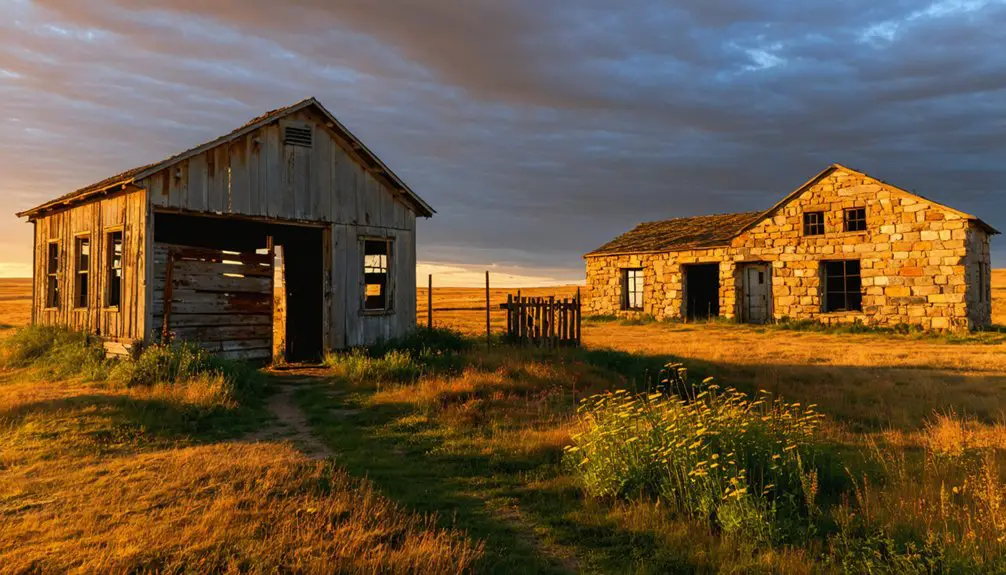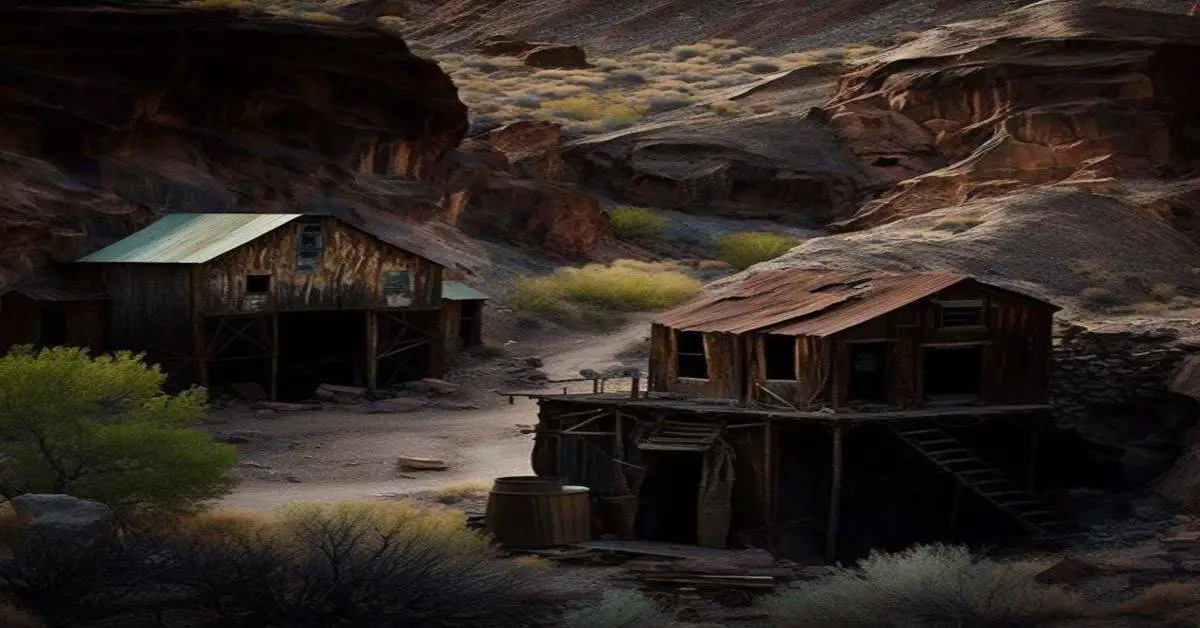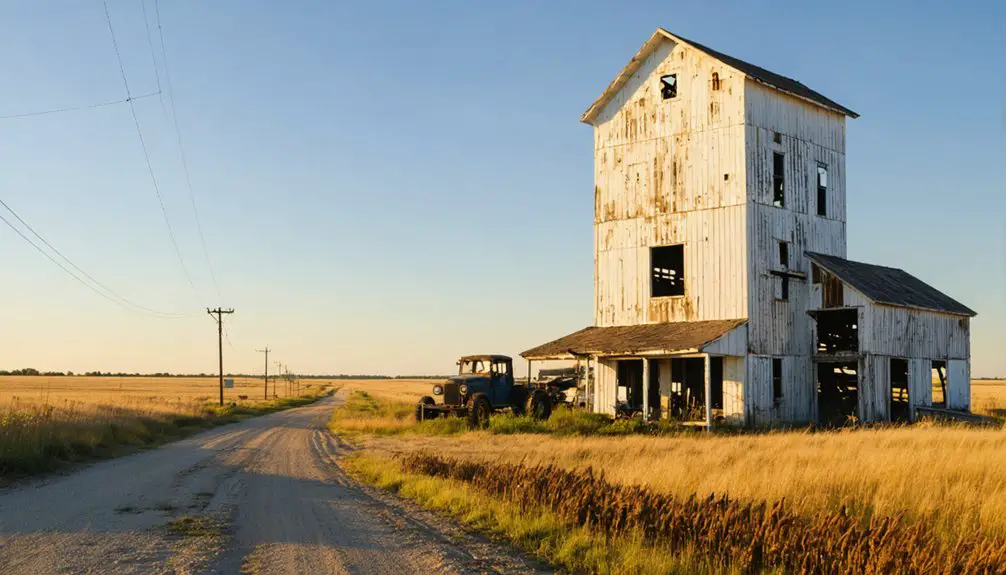You’ll find Fort Buford at the meeting point of the Missouri and Yellowstone Rivers in North Dakota, where this once-bustling military post played a vital role in America’s frontier era. Today, you can explore three remaining original structures, including the stone powder magazine and officers’ quarters museum, which offer self-guided tours and living history demonstrations. The fort’s most dramatic moment came in 1881 when Sitting Bull surrendered here, marking the end of an era that shaped the American West.
Key Takeaways
- Fort Buford transformed from an active military outpost to a ghost town after its decommissioning in 1895, leaving only three original structures standing.
- The site now operates as a state historic site, featuring a museum in the officers’ quarters and preserved powder magazine.
- Fort Buford’s remaining buildings showcase the transition from military stronghold to abandoned frontier settlement in North Dakota’s history.
- Visitors can explore self-guided tours of the ghost town’s remains, including reconstructed buildings and historical interpretive displays.
- The fort’s location at the Missouri-Yellowstone confluence remains historically significant despite its ghost town status, drawing history enthusiasts year-round.
The Strategic Location at Two Rivers’ Meeting
The strategic confluence of the Missouri and Yellowstone Rivers gave Fort Buford an unparalleled advantage in controlling westward expansion during America’s frontier era.
Fort Buford’s position at the Missouri-Yellowstone confluence proved vital for military control of America’s western expansion and frontier development.
When you stand at this historic river convergence today, you’ll understand why military planners chose this commanding position to establish a transportation hub that would shape the American West.
You’re looking at the same crucial junction that once served steamboat traffic heading westward, while overseeing the natural pathways used by your pioneering ancestors.
Originally constructed as a 360-foot square stockade, the fort grew substantially to accommodate the increasing military presence in the region.
The fort’s location allowed troops to monitor movement along both waterways, effectively controlling access to the northern plains.
This vantage point, which the Lewis and Clark Expedition recognized decades earlier, proved essential for protecting settler routes and maintaining supply lines that sustained America’s westward push.
Built using materials from Fort Union and Fort William, the new military post established a strong presence in the Dakota Territory.
Military Significance During the Indian Wars
You’ll discover Fort Buford‘s pivotal role as a military operations center during the Sioux Wars of 1876-1879, where it coordinated campaigns and served as an essential supply hub for U.S. forces.
The fort’s historical significance reached its peak when Lakota leader Sitting Bull surrendered here in 1881, marking the end of his resistance and years of conflict that had shaped the Northern Plains.
As you explore the grounds, you’ll appreciate how the fort’s strategic position at the confluence of two major rivers enabled troops to effectively control river routes and maintain military pressure during the challenging frontier period. After Sitting Bull’s surrender, soldiers focused on protecting Great Northern Railway crews and maintaining order in the territory. The fort’s original adobe buildings deteriorated rapidly, requiring complete reconstruction within just three years of being built.
Strategic Military Operations Center
Strategically positioned at the confluence of the Missouri and Yellowstone Rivers, Fort Buford emerged as one of the most significant military outposts during the Indian Wars of the 1870s.
You’ll find this fort served as the nerve center for military logistics and troop movements against Sioux resistance, particularly during the campaigns of 1876-1879.
The fort’s expansion from housing one company to accommodating six companies reflects its growing importance in the northern plains.
As a base of operations, it supported essential military expeditions, including those of Brig. Gen. George Crook, while maintaining pressure on non-treaty Sioux bands.
The fort’s presence proved critical in protecting railway construction crews and preventing unauthorized cross-border movement between the U.S. and Canada, making it an indispensable hub for military operations throughout the region.
Sitting Bull’s Final Stand
During Fort Buford’s most pivotal moments, Sitting Bull’s 1881 surrender marked a defining chapter in the fort’s military significance.
After years of leading Native resistance and seeking refuge in Canada following the Battle of Little Bighorn, you’ll find that this legendary Lakota leader finally surrendered at this strategic Missouri River outpost.
You can trace Sitting Bull’s legacy through Fort Buford’s role as both a containment point and changeover site. The chief faced harsh living conditions in Canada before making the difficult decision to surrender. Upon arriving with 186 followers, he expressed his desire for peace with the soldiers.
For five months, the fort’s garrison held him and his followers before their transfer to Standing Rock Agency.
The surrender at Fort Buford symbolized more than just one leader’s capitulation – it represented the closing chapter of large-scale armed conflict between the Lakota and U.S. military in the region, forever changing the Northern Plains landscape.
River Route Defense Hub
Fort Buford’s commanding presence at the confluence of the Missouri and Yellowstone Rivers established it as an important military stronghold in Dakota Territory.
You’ll find its strategic location gave the U.S. Army unprecedented territorial control over essential river trade routes that connected the northern plains to western territories.
Initially built as a modest stockade in 1866, the fort quickly expanded to accommodate multiple companies as hostilities intensified.
The military installation’s position near the Canadian border allowed troops to monitor cross-border movements while protecting survey crews and settlers.
During the height of the Indian Wars, the fort served as a critical supply hub and deployment center, enabling rapid military responses via waterways.
The Army maintained this important defensive position until changing times and peace rendered the fort’s strategic importance obsolete.
Life Behind Fort Walls: Daily Operations
You’ll find the daily operations at Fort Buford revolved around a complex network of support facilities, including a sawmill, bakery, butcher shop, and multiple storehouses that kept the garrison of six companies supplied and fed.
Inside the fort’s walls, soldiers maintained their quarters within adobe and wooden barracks while performing routine duties like equipment maintenance, construction work, and guard rotations.
The military command carefully orchestrated these activities through a structured chain of leadership, ensuring the coordination of essential services from the quartermaster’s storehouse to the hospital and guard house.
Military Daily Supply Operations
Strategically positioned at the confluence of the Missouri and Yellowstone rivers, Fort Buford’s daily supply operations served as the lifeblood of military campaigns throughout the Montana Territory.
You’ll find that supply chain management was essential, with quartermasters coordinating the movement of crucial goods via steamboat and overland routes.
The fort’s ammunition storage facilities, including a robust sandstone powder magazine built in 1875, safeguarded over a million rounds of black powder cartridges. Today, the stone powder magazine stands as one of the few remaining original structures at the site.
Supply clerks meticulously tracked inventory while managing daily rations for nearly 1,000 people, including infantry and cavalry units.
The fort’s civilian support staff maintained laundry services and repairs, while construction crews guaranteed important storage facilities remained operational.
Despite hostile raids and weather delays, Fort Buford’s supply operations kept frontier forces ready and equipped.
Soldiers’ Housing and Duties
Life behind Fort Buford’s walls revealed stark contrasts between officers’ and enlisted men’s housing conditions.
While officers enjoyed well-furnished adobe quarters with broad porches and shaded cottonwood walkways, enlisted soldiers endured cramped, poorly insulated barracks that offered little comfort against the harsh climate.
Your daily responsibilities as a soldier would’ve included constant guard duty, maintaining fort defenses, and protecting cattle from raids.
You’d have faced the challenges of repairing deteriorating adobe structures and expanding stockades for better security. With the fort’s expansion in 1871-1872, more barracks were needed to house the increased garrison of six companies.
The soldier accommodations were basic at best, with inadequate winter clothing and sparse furnishings.
To supplement your meager provisions, you might’ve tended one of the small gardens that soldiers maintained to combat scurvy and improve nutrition, showing the resourcefulness required to survive on the frontier.
Frontier Command Structure
The command structure at Fort Buford reflected a tightly organized military hierarchy that shaped every aspect of daily operations. At the top, you’d find the post commander, typically a captain or brevet lieutenant colonel, who wielded ultimate authority over the fort’s activities and personnel. Located on the Missouri River, the fort’s strategic position enhanced leadership’s ability to maintain effective control over regional military operations.
This frontier command hierarchy guaranteed:
- Swift response to Native American threats through coordinated defensive measures
- Efficient management of essential supplies and resources via the quartermaster system
- Clear communication channels between military departments through the adjutant’s detailed record-keeping
- Proper oversight of both military personnel and civilian employees like interpreters
The post leadership maintained order through a network of subordinate officers, each responsible for specific duties from administrative tasks to military expeditions. This created a self-sustaining community prepared for the challenges of frontier life.
Architecture and Building Challenges
Built in 1866, Fort Buford faced significant architectural challenges due to its reliance on locally sourced materials that proved inadequate for long-term durability.
You’ll find evidence of this in the fort’s original construction, which used handmade adobe bricks and green cottonwood lumber that began deteriorating within just three years.
The fort’s expansion from a 360-foot-square stockade to a 540 by 1,080-foot compound revealed ongoing material challenges.
While builders attempted to salvage aged wood from Fort Union for better quality, they couldn’t overcome the limitations of their semi-arid environment.
The General Alfred Sully led military efforts to protect these vulnerable structures during periods of unrest with local tribes.
The hastily built structures, criticized in an 1875 Surgeon General’s report, showcased the struggles of frontier construction.
Most buildings were simple one-story frames, except for adobe barracks and a stone powder magazine, reflecting the practical constraints of building on the American frontier.
Notable Historical Events and Conflicts
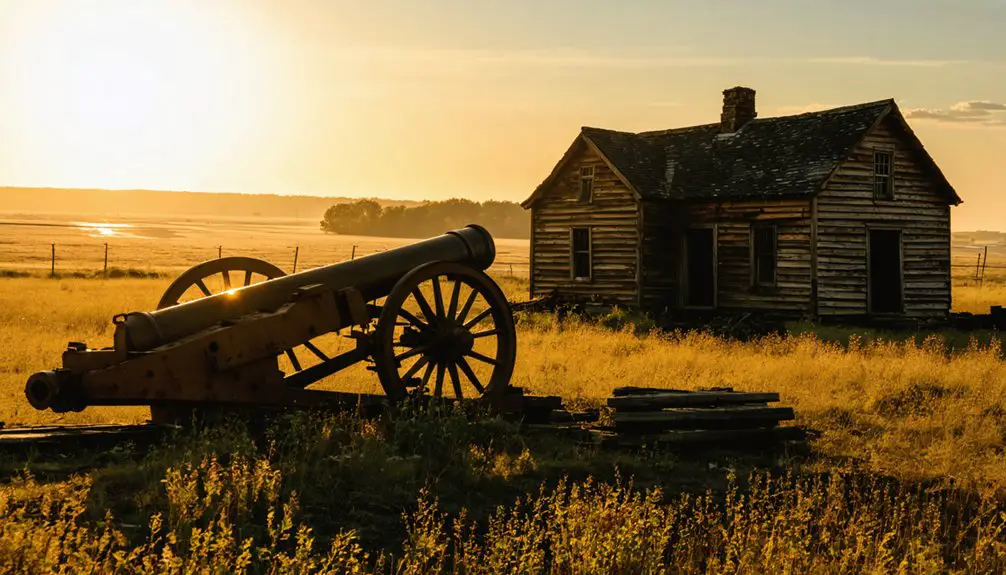
Following its establishment in 1866, Fort Buford endured intense conflict with Sioux warriors who viewed the outpost as an intrusion into their territory.
Fort conflicts escalated as Native Americans launched raids against construction crews and soldiers, reflecting the broader struggle for freedom and sovereignty in the region.
Key moments of Sioux resistance at Fort Buford include:
- Frequent attacks in spring 1867, causing casualties and sparking a nationwide massacre hoax
- Escalating tensions during the 1870s as railway surveys violated the 1868 Treaty
- Active involvement in the Great Sioux War, including the aftermath of Little Bighorn
- Sitting Bull’s historic surrender in 1881, when he presented his Winchester carbine to Major Brotherton
These events shaped Fort Buford’s legacy as a symbol of the changing American frontier and the end of traditional Plains Indian life.
The Legacy of Sitting Bull’s Surrender
Among Fort Buford’s most significant moments, Sitting Bull’s 1881 surrender stands as a defining event that shaped Native American-U.S. relations for generations to come.
When you visit the fort today, you’ll find yourself at the site where the renowned Lakota leader, accompanied by 187 of his people, made the difficult choice to lay down his Winchester rifle after years of resistance.
While the surrender marked the end of armed Sioux resistance in the Northern Plains, Sitting Bull’s legacy endures as a symbol of cultural resilience. His decision, driven by starvation and community pressures, reflected the broader struggles of Native peoples facing reservation policies.
Despite surrendering at Fort Buford, Sitting Bull’s defiant spirit became a lasting symbol of Native American resistance against injustice.
At Fort Buford, you can still explore the preserved structures that witnessed this pivotal moment in American frontier history.
From Active Fort to Abandoned Post
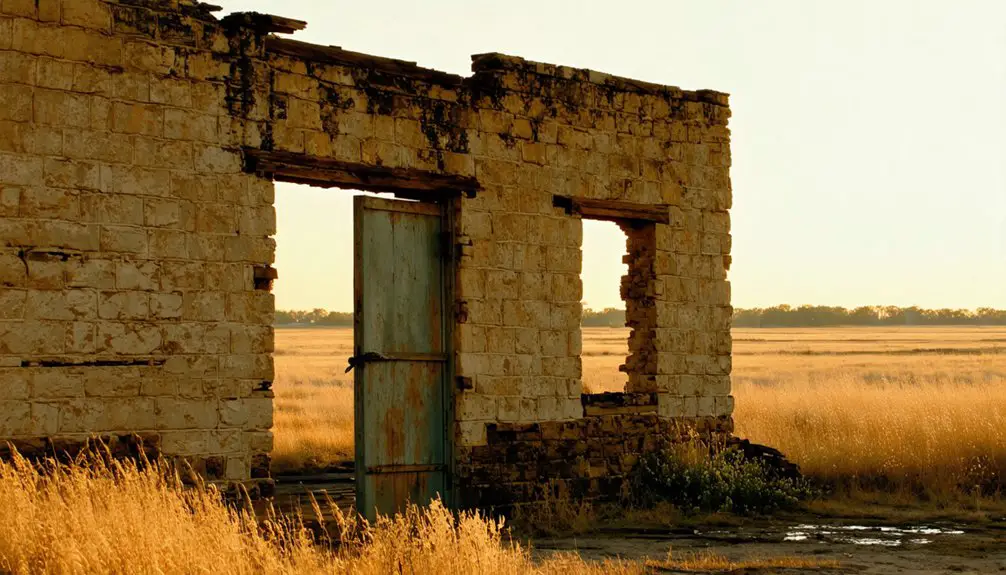
While initial construction of Fort Buford began in 1866 with a modest 360-foot-square stockade, the installation quickly expanded to meet growing military needs in Dakota Territory.
You can trace the fort’s legacy through its rapid growth, from housing a single company to accommodating six full companies by the 1870s.
Unfortunately, poor construction methods and harsh Dakota winters took their toll on the buildings.
The fort’s decline became evident through:
- Deteriorating adobe walls that couldn’t withstand the elements
- Water mains that consistently froze and failed during winter
- Structures that frequently collapsed due to unseasoned lumber
- Repair costs that eventually exceeded the fort’s military value
Present-Day Historical Site and Tourism
Today, Fort Buford stands as a tribute to frontier military history, preserved through thoughtful restoration and public stewardship.
You’ll find three original structures: the stone powder magazine, officers’ quarters museum, and officer of the guard building. While ghost stories occasionally circulate about the old fort grounds, visitor experiences focus on authentic historical interpretation through self-guided tours and living history demonstrations.
The 40-acre site offers year-round access to walking trails, fishing spots, and wildlife viewing. You can explore exhibits inside the officers’ quarters museum, which showcases military artifacts and frontier life.
At the nearby Missouri-Yellowstone Confluence Interpretive Center, you’ll discover murals depicting the Lewis and Clark expedition. The site’s preservation efforts include reconstructed adobe barracks and interpretive signs that bring the fort’s rich military heritage to life.
Cultural Impact on the Northern Plains
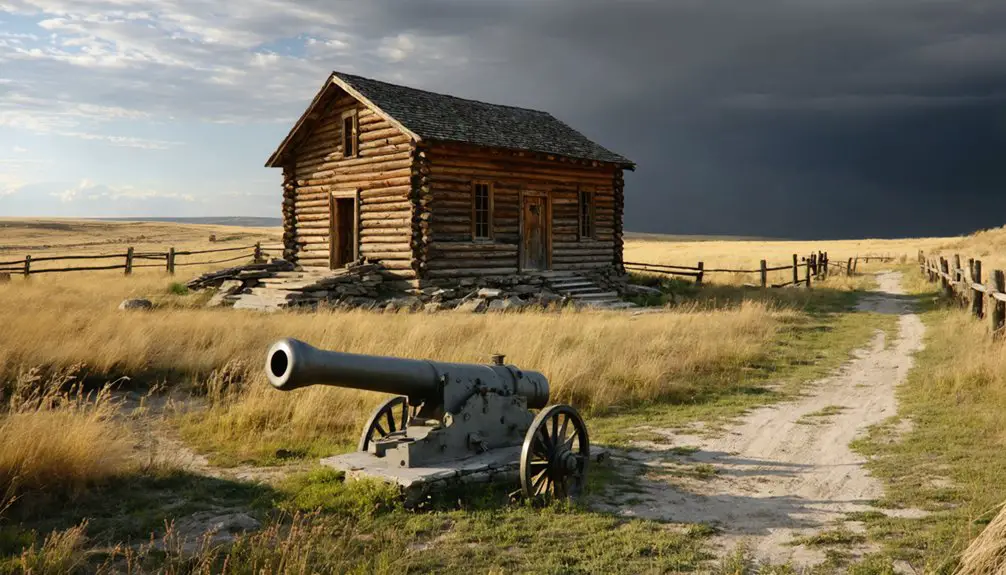
Fort Buford’s establishment in 1866 profoundly shaped cultural dynamics across the Northern Plains, particularly in its impact on Native American communities. The fort’s presence forever altered traditional ways of life, serving as both a symbol of cultural transformation and a catalyst for societal change.
Fort Buford stands as a testament to the profound cultural shifts that reshaped Native American life across the Northern Plains.
Today, you’ll find that indigenous narratives and cultural preservation efforts help tell the complex story of this pivotal site:
- The fort witnessed Sitting Bull’s historic 1881 surrender, marking a turning point in Sioux-U.S. relations.
- Its location at the Missouri-Yellowstone confluence disrupted traditional Native trade routes.
- The site represents the clash between U.S. expansion and Indigenous sovereignty.
- The fort’s diverse garrison created an early cultural contact zone between soldiers and Native peoples.
These lasting impacts continue to influence how we perceive and interpret Northern Plains history today.
Frequently Asked Questions
What Happened to the Soldiers’ Families After Fort Buford Was Abandoned?
You’ll find that soldiers’ families faced independent relocation as military support ended in 1895. They’d likely follow their reassigned soldiers or adapt by moving to nearby communities, though records don’t detail specific family adaptation.
Were There Any Documented Paranormal Activities or Ghost Sightings at Fort Buford?
You’ll find ghost encounters tied mainly to local folklore and tourism events at Fort Buford Cemetery. While spectral sightings are reported anecdotally near Cartwright Tunnel and the cemetery, there’s no formal scientific documentation.
How Did Winters Affect Communication Between Fort Buford and Other Military Posts?
You’ll find winter communication at Fort Buford was severely hampered by heavy snowfall, icy rivers, and extreme cold. Military logistics suffered as storms blocked roads, delayed couriers, and disrupted essential supply routes.
What Entertainment and Leisure Activities Did Soldiers Have at Fort Buford?
You’d find soldiers enjoying fishing, hiking, and historical reenactments, while card games, storytelling, and musical entertainment filled their evenings. Military drills and social gatherings around flag ceremonies provided structured leisure activities.
Did Any Famous Military Officers Besides Sitting Bull Visit Fort Buford?
You won’t find records of famous military visits beyond Lt. Colonel Rankin, who established the fort, and Sitting Bull’s surrender. Historical figures rarely traveled to this remote frontier military post.
References
- https://www.americanheritage.com/content/fort-buford
- https://www.history.nd.gov/historicsites/buford/bufordhistory.html
- http://coloradosghosttowns.com/Fort Buford.html
- https://en.wikipedia.org/wiki/Fort_Buford
- https://www.history.nd.gov/historicsites/buford/
- https://ghostsofnorthdakota892857007.wordpress.com/2015/05/29/abandoned-fort-buford/
- https://www.ndtourism.com/williston/attractions-entertainment/hidden-gem-attractions/fort-buford-state-historic-site
- https://www.hmdb.org/m.asp?m=96746
- https://npgallery.nps.gov/GetAsset/8e414cd2-ad95-4906-8172-9bcc70618fc0
- https://www.legendsofamerica.com/fort-buford-north-dakota/
